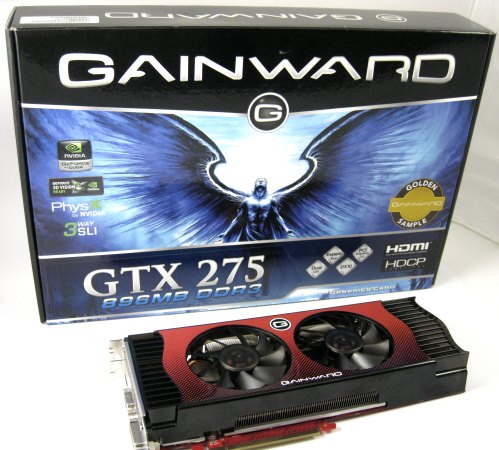Index
![]()
Review: Non-reference cooling and a factory overclock
If you are planning to buy a gaming graphics card, it's no secret that Geforce GTX 275 is still one of the best picks. In order to ruin AMD's party, Nvidia announced this card on the same day when AMD announced Radeon HD 4890. It is positioned slightly cheaper compared to the HD 4890 and these two cards promised to be fierce competitors. Speed-wise, we'd put the GTX 275 closer to the GTX 285 than the GTX 260, and a little bit of overclocking will help you match its results to the ones scored by the much pricier GTX 285. GTX 275 should perform on par with the discontinued GTX 280. It differs from GTX 260 and GTX 285 only in some characteristics, such as the number of active execution units and clock rates.
Out today's guest is Gainward's GTX 275 Golden Sample. We are looking at a non-reference GTX 275 card that comes with a completely different PCB and cooling. The GPU runs at 648MHz, the memory at 1185MHz and the shaders at 1420MHz. Gainward's clocks are a bit higher compared to reference's 633MHz core, 1134MHz memory and 1404MHz shaders.
Unlike the reference card with dual slot cooling and one fan, Gainward uses two fans in order to maximize cooling efficiency and provide silent operation.
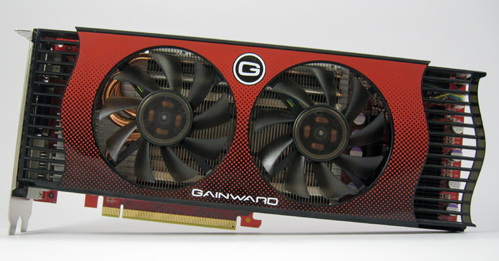
The cooler seems a bit larger than the reference one and makes the card look longer, but it’s exactly two slots wide and about 27 centimeters long, just like the reference card.
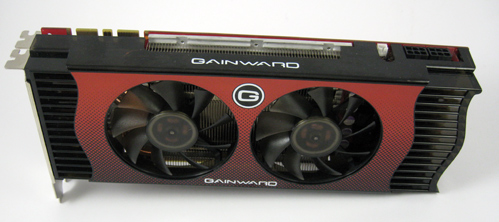
The cooler houses two large 8cm diameter fans connected to the 4-pin connector via one cable, and rpm regulation is a breeze.
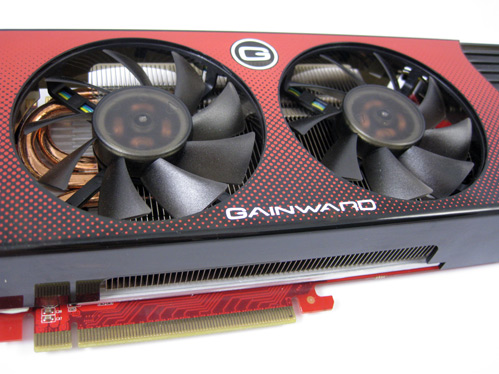
Note that both fans run at same speed.
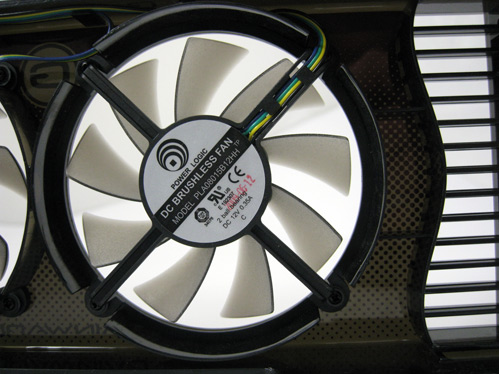
Underneath the fan is a large heatsink with three heatpipes, and the plastic hood that holds the fans in place covers the entire card. Since this is a card with one graphics processor, both fans are placed in a way to equally distribute air over the GT200 GPU and one heatsink.
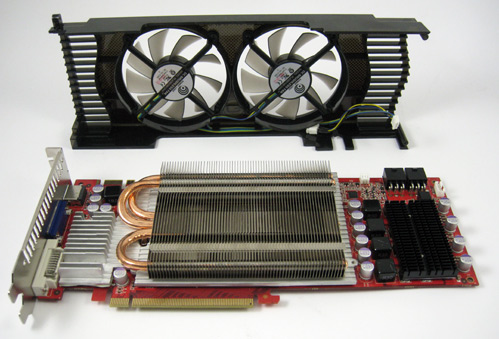
Gainward's GTX275 GS still features the same design and the general looks of Gainward's first GTX 275 card, which runs on reference speed. This time around however, you see one suffix – GS, which stands for Golden Sample and means higher clocks. Unfortunately, this time Gainward did not make famous “Goes Like Hell” version of GTX 275 card.
The same cooling we see here is used for all Gainward's GTX 260 cards. GTX 275 temperatures are higher than on the GTX 260, but Gainward’s cooling keeps them in check.
Compared to the reference card, Gainward’s card is cooler, keeping the temperatures at about 83 degrees Celsius when under a workload (reference cards run at about 89 degrees Celsius) and about 34 degrees Celsius in idle mode (a couple of degrees Celsius lower compared to reference cards’ temperatures).
The card runs almost inaudible in idle mode. While we'd say Gainward's GTX 275 GS should've been made to run a bit quieter at default settings, it's still nothing a manual RPM setting won't fix. Note that silence doesn't come without a price, so you'll probably sacrifice a couple of °C to achieve your preferred noise levels. During operation it is not loud, but it could be quieter.
A large heatsink with three heatpipes covers the most of the card’s surface, but it only touches the core. The picture below shows the three heatpipes going from the copper base to different parts of the heatsink.
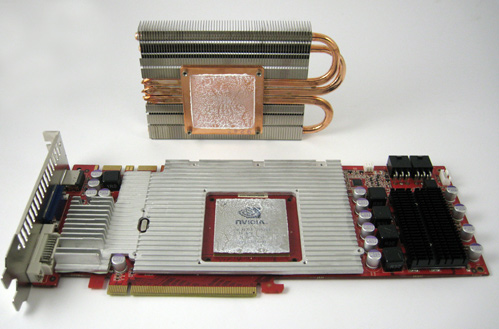
Gainward GTX 275 GS card has reference configuration featuring 896MB DDR3 memory. All 14 memory chips are on the front of the card, located underneath the aluminum block, which is nicely cooled by the fan. The card features 448-bit memory bus that binds to seven 64-bit memory controllers inside the GPU. Such a strange number is a direct result of disabling one ROP partition. The GTX 275 has 240 28 ROPs and 80 texture filtering units. Note that GTX 275 is DirectX 10 card.
The memory in question is Samsung's 0.8ns memory - K4J52324QH-HJ08, used by Gainward on their GTX 275, GTX260 GS, GTX260 GS GLH ans some other cards. This memory is rated at 1200MHz, and despite running at 1185MHz on the GTX 275, it’s easily overclockable to 1200MHz+.
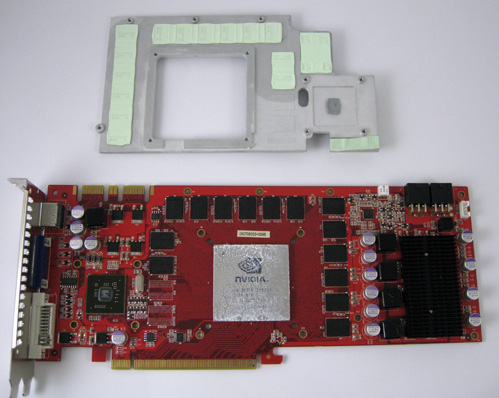
The picture below reveals that power components are cooled with a separate black heatspreader. Two fan design used by Gainward is efficient, but the most heat released from dissipation surfaces stays in the case, whereas reference cooling pushes it out. This however should not be a problem if your in-case airflow is adequate.
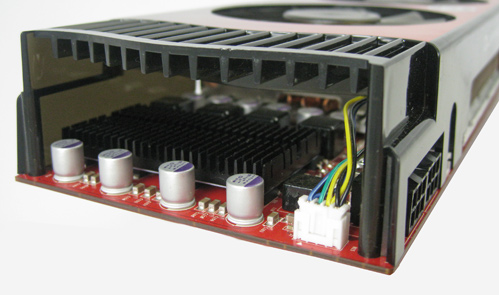
Gainward uses non-reference PCB, with 4+1 phase PWM design. As you already might have noticed, the memory power components got relocated to the opposite side.
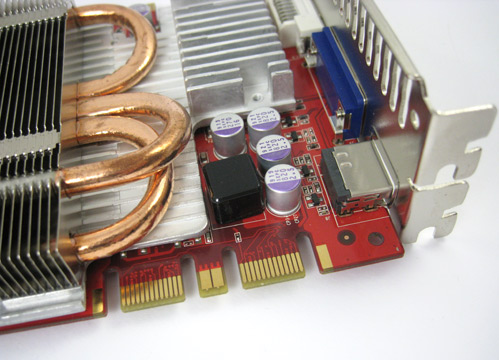
Thanks to the GT200 55nm chip on the GTX 275, consumption stays in acceptable limits. Maximum TDP goes up to 219W and the card has two 6-pin power connectors.
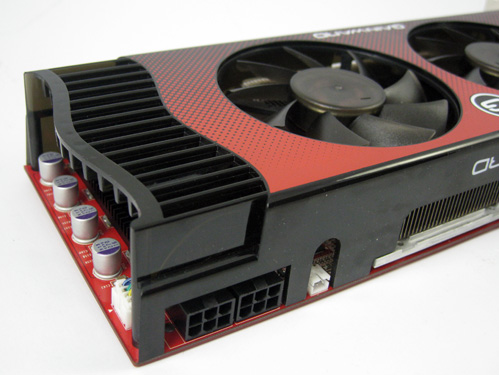
Furthermore, when the graphics card is idle, the card downclocks to 300MHz core, 601MHz shader s and 250MHz for the memory. Such operation mode enables power saving – our test system consumed less than 100W in idle and up to 315W during gaming.
The GTX 275's consumption is higher than on the HD 4890, but thanks to more efficient 2D/3D operation mode, Geforce cards are usually more efficient in idle mode, as Radeons keep the 3D memory clocks in idle mode as well.
If you crave more performance, you can always combine one or two more cards, connecting them with two provided SLI connectors.
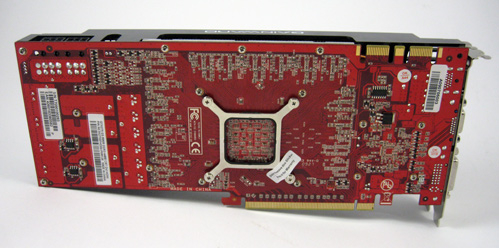
Compared to the reference GTX 275 card and to the Gainward's GTX 275, Gainward's GTX 275 Golden Sample card has native HDMI out. Along with the HDMI, the I/O panel features one dual-link DVI and VGA out. If you want both video and audio you'll have to bring sound to your graphics card first via a SPDIF cable. This is a standard thing with Nvidia's cards, and you'll be connecting one end of the cable to the connector next to the power connectors, and the other one to the SPDIF out on the motherboard or the sound card.
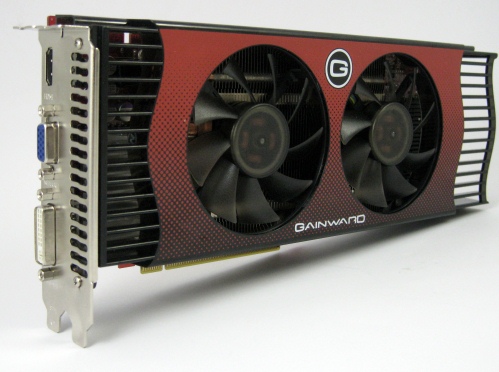
The packaging keeps the card safe but it is a bit too large for our taste. All the accessories are within the box - HDMI-to-DVI converter, one power cable with dual 4-pin Molex-to-6-pin PCI Express adapter, SPDIF cable, driver CD and the user's manual.
